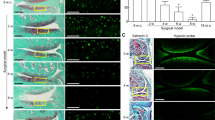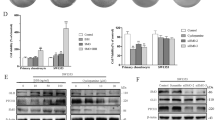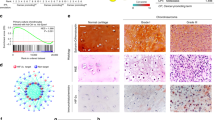Abstract
Connective tissue growth factor (CTGF/CCN2) can be induced by various forms of stress such as exposure to high glucose, mechanical load, or hypoxia. Here, we investigated the molecular mechanism involved in the induction of ctgf/ccn2 by hypoxia in a human chondrosarcoma cell line, HCS-2/8. Hypoxia increased the ctgf/ccn2 mRNA level by altering the 3′-untranslated region (UTR)-mediated mRNA stability without requiring de novo protein synthesis. After a series of extensive analyses, we eventually found that the cis-repressive element of 84 bases within the 3′-UTR specifically bound to a cytoplasmic/nuclear protein. By conducting a UV crosslinking assay, we found the cytoplasmic/nuclear protein to be a 35 kDa molecule that bound to the cis-element in a hypoxia-inducible manner. These results suggest that a cis-element in the 3′-UTR of ctgf/ccn2 mRNA and trans-factor counterpart(s) play an important role in the post-transcriptional regulation by determining the stability of ctgf/ccn2 mRNA.
This is a preview of subscription content, access via your institution
Access options
Subscribe to this journal
Receive 50 print issues and online access
$259.00 per year
only $5.18 per issue
Buy this article
- Purchase on Springer Link
- Instant access to full article PDF
Prices may be subject to local taxes which are calculated during checkout






Similar content being viewed by others
References
Babic AM, Chen CC, Lau LF . (1999). Mol Cell Biol 19: 2958–2966.
Bork P . (1993). FEBS Lett 327: 125–130.
Bradham DM, Igarashi A, Potter RL, Grotendorst GR . (1991). J Cell Biol 114: 1285–1294.
Brigstock DR . (1999). Endocr Rev 20: 189–206.
Carmeliet P, Jain RK . (2000). Nature 407: 249–257.
Chen CY, Shyu AB . (1995). Trends Biochem Sci 20: 465–470.
Czyzyk-Krzeska MF, Dominski Z, Kole R, Millhorn DE . (1994). J Biol Chem 269: 9940–9945.
Dehlin E, Wormington M, Korner CG, Wahle E . (2000). EMBO J 19: 1079–1086.
Dreyfuss G, Kim VN, Kataoka N . (2002). Nat Rev Mol Cell Biol 3: 195–205.
Eguchi T, Kubota S, Kondo S, Shimo T, Hattori T, Nakanishi T et al. (2001). J Biochem (Tokyo) 130: 79–87.
Fan XC, Steitz JA . (1998). Proc Natl Acad Sci USA 95: 152935–152938.
Ford LP, Wilusz J . (1999). Methods 17: 21–27.
Goldberg-Cohen I, Furneauxb H, Levy AP . (2002). J Biol Chem 277: 13635–13640.
Hew Y, Grzelczak Z, Lau C, Keeley FW . (1999). J Biol Chem 274: 14415–14421.
Hew Y, Lau C, Grzelczak Z, Keeley FW . (2000). J Biol Chem 275: 24857–24864.
Higgins DF, Biju MP, Akai Y, Wutz A, Johnson RS, Haase VH . (2004). Am J Physiol Renal Physiol 287: 1223–1232.
Kondo S, Kubota S, Shimo T, Nishida T, Yosimichi G, Eguchi T et al. (2002). Carcinogenesis 23: 769–776.
Korner CG, Wormington M, Muckenthaler M, Schneider S, Dehlin E, Wahle E . (1998). EMBO J 17: 5427–5437.
Kubota S, Hattori T, Nakanishi T, Takigawa M . (1999). FEBS Lett 450: 84–88.
Kubota S, Kondo S, Eguchi T, Hattori T, Nakanishi T, Pomerantz RJ et al. (2000). Oncogene 19: 4773–4786.
Kubota S, Moritani NH, Kawaki H, Minura H, Minato M, Takigawa M . (2003). Bone 33: 694–702.
Kubota S, Mukudai Y, Moritani NH, Nakao K, Kawata K, Takigawa M . (2005). FEBS Lett 579: 3751–3758.
Kumar S, Hand AT, Connor JR, Dodds RA, Ryan PJ, Trill JJ et al. (1999). J Biol Chem 274: 17123–17131.
Kunz M, Ibrahim SM . (2003). Mol Cancer 2: 1–13.
Kunz M, Moeller S, Koczan D, Lorenz P, Wenger RH, Glocker MO et al. (2003). J Biol Chem 278: 45651–45660.
Lau LF, Lam SC . (1999). Exp Cell Res 248: 44–57.
Levy AP, Levy NS, Goldberg MA . (1996a). J Biol Chem 271: 2746–2753.
Levy AP, Levy NS, Goldberg MA . (1996b). J Biol Chem 271: 25492–25497.
Levy AP, Levy NS, Wegner S, Goldberg MA . (1995). J Biol Chem 270: 13333–13340.
Levy NS, Chung S, Furneaux H, Levy AP . (1998). J Biol Chem 273: 6417–6423.
Macdonald LE, Durbin RK, Dunn JJ, McAllister WT . (1994). J Mol Biol 238: 145–158.
Macdonald LE, Zhou Y, McAllister WT . (1993). J Mol Biol 232: 1030–1047.
Mukudai Y, Kubota S, Takanori E, Kondo S, Nakao K, Takigawa M . (2005). J Biol Chem 280: 3166–3177.
Rajagopalan LE, Malter JS . (1994). J Biol Chem 269: 23882–23888.
Ratnam S, Maclean KN, Jacobs RL, Brosnan ME, Kraus JP, Brosnan JT . (2002). J Biol Chem 277: 42912–42918.
Rondon IJ, MacMillan LA, Beckman BS, Goldberg MA, Schneider T, Bunn HF, Malter JS . (1991). J Biol Chem 266: 16594–16598.
Ross J . (1995). Microbiol Rev 59: 423–450.
Shih S, Claffey KP . (1998). Int J Exp Pathol 79: 347–357.
Shih SC, Claffey KP . (1999). J Biol Chem 274: 1359–1365.
Shimo T, Nakanishi T, Kimura Y, Nishida T, Ishizeki K, Matsumura T et al. (1999a). J Biochem 124: 130–140.
Shimo T, Nakanishi T, Nishida T, Asano M, Kanyama M, Kuboki T et al. (1999b). J Biochem 126: 137–145.
Takigawa M . (2003). Drug News Perspect 16: 11–21.
Takigawa M, Nakanishi T, Kubota S, Nishida T . (2003). J Cell Physiol 194: 256–266.
Takigawa M, Tajima K, Pan HO, Enomoto M, Kinoshita A, Suzuki F et al. (1989). Cancer Res 49: 3996–4002.
Wang GL, Semenza GL . (1993). J Biol Chem 268: 21513–21518.
Wang GL, Jiang BH, Rue EA, Semenza GL . (1995). Proc Natl Acad Sci USA 92: 5510–5514.
Acknowledgements
This work was supported in part by the programs Grants-in-Aid for Scientific Research (SK, SK, MT) and Exploratory Research (MT) of the Ministry of Education, Science, Sports, and Culture of Japan; Grants-in-Aid for JSPS Fellows (SK); Grants-in-Aid for Specific Diseases of the Ministry of Public Health and Welfare of Japan (MT); and by grants from the Naito Foundation (MT), the Nakatomi Health Science Foundation (SK, MT), the Foundation for Growth Science in Japan (MT), the Sumitomo Foundation (MT), and Research for the Future Programme of The Japan Society for the Promotion of Science (JSPS; Project: Biological Tissue Engineering, JSPS-RFTF98I00201). We thank Drs Tohru Nakanishi and Takanori Eguchi for their helpful suggestions, Kazumi Ohyama for technical assistance, and Yuki Nonami for secretarial help.
Author information
Authors and Affiliations
Corresponding author
Rights and permissions
About this article
Cite this article
Kondo, S., Kubota, S., Mukudai, Y. et al. Hypoxic regulation of stability of connective tissue growth factor/CCN2 mRNA by 3′-untranslated region interacting with a cellular protein in human chondrosarcoma cells. Oncogene 25, 1099–1110 (2006). https://doi.org/10.1038/sj.onc.1209129
Received:
Revised:
Accepted:
Published:
Issue Date:
DOI: https://doi.org/10.1038/sj.onc.1209129
Keywords
This article is cited by
-
Tumor Hypoxia As an Enhancer of Inflammation-Mediated Metastasis: Emerging Therapeutic Strategies
Targeted Oncology (2018)
-
Rho-kinase inhibitor Y-27632 and hypoxia synergistically enhance chondrocytic phenotype and modify S100 protein profiles in human chondrosarcoma cells
Scientific Reports (2017)
-
Decreased expression of connective tissue growth factor in non-small cell lung cancer is associated with clinicopathological variables and can be restored by epigenetic modifiers
Journal of Cancer Research and Clinical Oncology (2016)
-
CCN2 Expression by Tumor Stroma Is Required for Melanoma Metastasis
Journal of Investigative Dermatology (2015)
-
Targeting connective tissue growth factor (CTGF) in acute lymphoblastic leukemia preclinical models: anti-CTGF monoclonal antibody attenuates leukemia growth
Annals of Hematology (2014)



